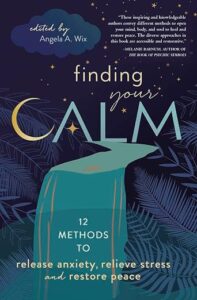Do you feel anxious or stressed? Are you struggling with chronic pain or have trouble sleeping? Do you have looping negative thoughts and worries? Perhaps you’re constantly in a time crunch, or you’ve recently realized your life seems to be perpetually fueled by adrenaline from an underlying sense of panic. Trauma, fried nerves, feeling wired, on edge, unsafe, overwhelmed, exhausted—this list could go on and on, but I’m sure by now you get the point. If any of this seems to be ringing a bell, you’re not alone, and it’s time you take a pause for a moment to find your calm.
Whether you’re facing heightened anxiety and panic attacks, burnt out with responsibility and the pace of modern life, or struggling with any number of our current world challenges and traumas, finding your calm has become a vital act.
The thing about finding your calm, though, is that it’s a highly individual act.
We’ve all heard the standard offerings: take a deep breath, meditate, think positively, exercise, drink water, cut out caffeine, get enough sleep. The list is so often repeated that it practically writes itself! But finding what actually works for you within the details of those various recommendations can prove to be more complex.
The fact is, deep breathing may actually worsen anxiety for some people, and if you have PTSD, meditation could leave you re-triggered by traumatic memories. Positive thinking can sometimes become a counter-productive, slippery slope to toxic positivity if you disregard emotions like anger, frustration, grief, or sadness that are trying to help you understand your authentic needs. Even the seemingly obvious recommendation around caffeine isn’t so black-and-white, as it can actually help some neurodiverse individuals manage challenging symptoms, such as poor concentration and hyperactivity.
In the end, finding your calm is a very personal thing. The traditional recommendations might work perfectly for you, and if so, great! But if you feel like you’re still exploring what does or doesn’t work for you, and you’d like to find some new things to try, here are a few ideas.
- Make a Love List
I have a terrible memory and find it somewhat amusing that this also means I frequently completely forget what it is that I enjoy. Keeping a running list of things that I love helps me refocus when I’m lost for ways to self-soothe. I think this is a practice we all can benefit from. Even if you have an excellent memory, when we’re stressed or in the low swings of depression, it can be especially difficult to think of those things that might give us a boost of positivity.Break it down! What did you love as a kid or where do you get lost in time now? Don’t limit yourself. Think people, places, things, activities, shows, books, feelings, etc. My list includes everything from holiday décor and musical theater to dogs, biking, soft blankets, and the sound of fabric being cut with scissors. Keep your list handy for whenever something new is experienced or comes to mind and add to it as you go!
- Tap into Music
Try to think of a song that taps into a really happy time in your life. Maybe it’s a wedding song, something you played on repeat in the car with your friends as a teenager, or a playlist you used to listen to during holidays with family.For me, the theme songs to Full House and Reading Rainbow are two jingles that are guaranteed to get me to pause, slow my breath, and smile from the heart. They bring to mind some of the coziest times with my family. I also get this feeling from holiday music, a favorite movie soundtrack, and an old CD that I used to listen to at night as a kid in the quiet of my bedroom as I went to sleep.
As you consider what your selected music might be that puts you in your place of calm, keep in mind that this doesn’t necessarily mean the music itself is of a calming style. The key is that it imparts a sense of happiness, peace, or pleasant nostalgia that leaves you yourself in a more centered state of mind.
- Combine for a Calming Practice
Combining those two details, find a practice that leaves you feeling still, centered, and happy. Look back to your list of loved things and pull out one detail that you can act on right now. Pair it with some of your music if you can, and experience it together in this moment. Pay attention to how this combination affects you.In my own experience, I paired a loved visual with a calming soundtrack. I’m very sensory sensitive, and love sparkly things. As a kid I was captivated by a small, fiber-optic tree that played a holiday song. I used to go into a dark room, wind it up, and watch it at length, absorbing the tinkling sound of “Oh Christmas Tree” set against the transition of light and color. I recently received a fiber-optic decoration and was surprised by how completely absorbed I still am by this type of visual. Set against some of my favorite music, I sat, watched, and listened in a state of peace and joy. As someone with inattentive focus and an absolutely noisy mind, it felt like magic and is a practice I now love to come back to when I need to recenter.
What about you?
Hopefully this brief practice will leave you with a place to start, but don’t forget to keep looking for what works for you. Maybe that means exploring aromatherapy, chakra work, astrology, Emotional Freedom Technique (EFT), your innate body wisdom, empathic self, and the wonders of the vagus nerve. You can explore these and even more relaxation methods by checking out the book Finding Your Calm.
ABOUT THE AUTHOR:
Angela A. Wix (Western Wisconsin) has acquired body-mind-spirit titles for Llewellyn Worldwide. She is a Certified Medical Reiki Master (CMRM), Certified Massage Therapist (CMT), and lifelong intuitive medium-in-training. She is the author of The Secret Psychic and Llewellyn’s Little Book of Unicorns, and she has contributed her art and writing to additional Llewellyn titles, including Finding Your Calm, Llewellyn’s 2025 Magical Almanac, and Llewellyn’s Complete Book of Mindful Living. For more, visit her on Facebook and Instagram @AngelaAWix or online at www.AngelaAnn.Wix.com/arts.
Here’s a look at Angela’s latest release, where she join several authors with advice on
 Your Relaxation Solution is Here
Your Relaxation Solution is Here
Twelve of Llewellyn’s top authors introduce you to a dozen New Age relaxation techniques that can positively impact all areas of your life. Pulling from both scientific and spiritual methods, these experts present simple practices that will help you achieve a state of calm, including:
Body Wisdom by Emily Francis
Empaths by Kristy Robinett
Aromatherapy by Gail Bussi
Visualization by Chanda Parkinson
Chakra Work by Jiulio Consiglio
Astrology by Leah Patterson
Vagus Nerve by Cyndi Dale
Meditation by Shai Tubali
EFT by Amy B. Scher
Good Sleep by Angela Wix
ASMR by Shannon Yrizarry
Mindfulness by Melanie Klein
Featuring fun, conversational essays, this book explores a wide range of ways to promote peace and relaxation. You’ll learn how to use essential oils, listen to your emotional and energetic bodies, tailor your self-care routine to your sun sign, change your response to stress through tapping, and much more. Finding Your Calm helps you tune into your innate intuition and find the right modality for any moment.






